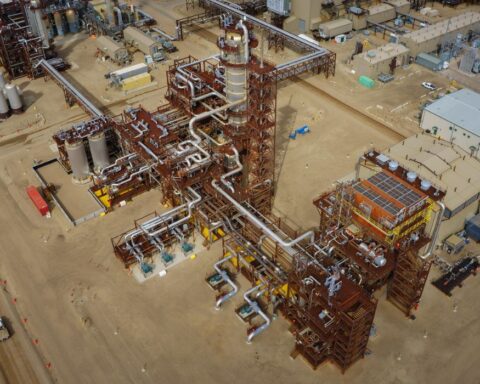Governments around the world are promoting clean-burning hydrogen as a critical component of our net-zero drive to avert the most catastrophic impacts of climate change.
In Canada, the federal government’s 2020 hydrogen strategy posits the fuel could supply as much as 30% of Canada’s final energy consumption by 2050. That may be wildly optimistic: the Canadian Climate Institute released a report in February 2021 that found that hydrogen could supply 3 to 10% of energy demand by 2050.
Still, several provinces have their own hydrogen strategies. And companies are looking for government assistance to help finance projects that would build out a hydrogen infrastructure, from production to consumption.
In the great debate over the global energy transition, natural gas producers and their political backers insist there is ample room in a net-zero world for “blue hydrogen,” which is made using gas. Many environmental advocates argue that government support should be provided only to “green hydrogen” that is produced using renewable electricity.
A number of governments agree. Germany – which has ruled out providing subsidies for gas-fuelled hydrogen production – signed a deal with Canada this summer to support the development and export of “green” hydrogen, which is made using renewable power such as offshore wind.
Still, fossil fuel proponents are pushing to deploy North America’s vast natural gas infrastructure to produce hydrogen for transportation, industry and even some building heating.
In Edmonton’s industrial heartland, energy companies are looking to develop blue hydrogen projects that will use natural gas as a feedstock, with plans to capture most carbon dioxide emissions from plants and sequester them underground. The bulk of hydrogen currently made in Canada (about three million tonnes in 2020) is made from natural gas without carbon capture technology, otherwise known as grey hydrogen. But that may be changing.
Allentown, Pennsylvania–based Air Products will begin construction this fall on a $1.6-billion plant that it says can capture roughly 95% of CO2 emissions and provide low-carbon hydrogen to customers in Alberta.


At the same time, Suncor Energy and ATCO, both of Calgary, are jointly pursuing a $4-billion plant near Edmonton that would produce 300,000 tonnes of hydrogen annually in its first phase, with a planned expansion to 900,000 tonnes per year.
In an interview in September, officials from Suncor and ATCO said the firms are now in advanced planning on the hydrogen project and have chosen a site at ATCO’s existing energy centre in Fort Saskatchewan. The firms hope to make a final decision to proceed early in 2024, with plant start-up by the end of 2027.
Both projects will use a new process called autothermal reforming, which claims to allow for greater capture than the traditional steam methane reforming approach. In both, much of the “low-carbon hydrogen” will be used at refineries owned by Suncor and Air Products partner Imperial Oil to reduce the carbon content of their liquid fuels.
Can blue hydrogen truly be low-carbon?
In the dispute over whether blue hydrogen can be green, some analysts suggest that hydrogen from natural gas can be a very low-carbon energy source, but those claims hinge on assumptions that are open to challenge. They argue the focus shouldn’t be on the colour but rather on the life-cycle carbon intensity of the fuel. However, natural-gas-based hydrogen is not currently carbon-competitive with green hydrogen – even with carbon capture.
The fledgling industry faces enormous challenges in making the promise of low-carbon blue hydrogen a reality.
There are two overriding factors: the amount of emissions involved in the extraction, processing and transport of the gas feedstock, and the efficiency of carbon capture at the plant together with the permanence of sequestration.
The conclusion that gas-based hydrogen can be low carbon assumes that the industry can virtually eliminate carbon dioxide and methane emission leaks from the gas system. It also would require the hydrogen producers to meet their ambitious carbon-capture targets and ensure the carbon is permanently sequestered. Considerable skepticism is warranted.
In an assessment released in September, the Institute for Energy Economics and Financial Analysis reviewed 13 large-scale carbon capture and storage (CCS) projects and found they had almost all significantly under-performed on promised emission reductions.
In an open letter to Finance Minister Chrystia Freeland earlier this year, some 400 academics from science, engineering and other disciplines urged the government to drop its planned tax credit for CCS. Instead, Freeland confirmed it in her 2022 budget.
The academics argued that CCS “is neither economically sound nor proven at scale, with a terrible track record and limited potential to deliver significant, cost-effective emissions reductions.”
Critics maintain that the expansion of gas-based hydrogen production is merely locking in our reliance on climate-warming fossil fuels and on an industry that has failed to live up to its environmental commitments.
“It’s not realistic to believe that blue hydrogen can ever be a zero-emission energy source,” says Julia Levin, national climate program manager at Environmental Defence. Where hydrogen is needed, it should be produced only from renewable electricity through the process of electrolysis, she argues.
Green hydrogen on the rise
For green hydrogen, electrolyzers are used to split water into hydrogen and oxygen. The process is significantly more expensive per tonne of hydrogen than the natural gas process – even with the high costs of CCS – but electrolyzer costs are falling rapidly.
The UN-based International Renewable Energy Agency has forecasted that by 2030 – and perhaps as early as 2028 – the hydrogen from renewable power will be cheaper than gas-derived hydrogen with carbon capture.
Countries around the world – including Australia, Egypt, Chile and India – are pursuing large-scale hydrogen plants powered by renewable energy.
On Canada’s East Coast, Nova Scotia and Newfoundland and Labrador both see significant opportunity for offshore wind to be used in hydrogen production. During an August visit, German Chancellor Olaf Scholz joined Prime Minister Justin Trudeau in Newfoundland, where they signed an agreement that commits to developing wind-generated hydrogen for export to Europe.
Where there is existing natural-gas infrastructure, provincial governments are still looking for opportunities to maintain and extend its economic value.
Sean McCoy, an assistant professor in the Department of Chemical and Petroleum Engineering at the University of Calgary, says blue hydrogen can be competitive on a carbon-intensity basis with hydrogen from renewable sources, assuming ultra-low amounts of methane leakage upstream and greater than 90% efficiency of carbon capture at the plant.
Perhaps a bigger thorn for blue hydrogen than the efficiency of CCS is the level of emissions – especially methane – that occur in the extraction, processing and transportation of natural gas. Methane is a potent greenhouse gas with a global warming potential 83 times that of CO2 over a 20-year time frame.
It’s not realistic to believe that blue hydrogen can ever be a zero-emission energy source.
-Julia Levin, national climate program manager at Environmental Defence
McCoy notes that numerous studies have shown that Canada is “chronically underestimating” the amount of methane being emitted by the oil and gas sector. He points to a 2020 study concluding that emissions could be as much as 60% higher than is being reported in Alberta and Saskatchewan. Any hydrogen project that wants to assert a low carbon intensity will have to provide compelling evidence that its gas suppliers properly track and eliminate methane emissions from their supply chains.
McCoy calculates that GHG emissions from green hydrogen would average roughly three kilograms of CO2 equivalent (CO2e) per kilogram of hydrogen. Blue hydrogen with high levels of methane leakage and low levels of CCS efficiency (55% capture) would emit 24 kilograms of CO2e. Blue hydrogen where methane leakage is virtually eliminated and CCS captures 93% of emissions would be roughly equivalent in carbon intensity to green hydrogen.
The hitch for environmental advocates: this has yet to be proven at commercial scale.
McCoy says industry can eliminate fugitive methane emissions relatively cheaply. David Layzell, a Calgary-based energy systems expert with The Transition Accelerator, a net-zero think tank supported by Canadian charitable foundations, says the technology should quickly become viable as carbon levies rise under a Liberal government plan to gradually increase the carbon price to $170 a tonne by 2030.
As with green hydrogen and other low-carbon technology, costs will come down as more projects are built, Layzell says, adding that newer technology is now promising to allow greater capture efficiency and less reliance on electricity from the grid that can be another source of carbon emissions. And in Canada, blue hydrogen plants will qualify for federal tax incentives, so long as the hydrogen isn’t used to spur production of oil from old wells in enhanced recovery projects.
South of the border, U.S. President Joe Biden’s Inflation Reduction Act includes the largest hydrogen subsidies in the world. Though it provides some funding for blue hydrogen, it has far greater incentives for green hydrogen producers. The bill – which passed in September – “immediately makes green hydrogen a competitive source of energy compared to its fossil fuel alternatives,” a briefing from law firm Shearman & Sterling said.
Natural Resources Minister Jonathan Wilkinson argues Canada needs to ensure it remains competitive with the United States in developing and deploying hydrogen technology. This week, the minister announced $800 million in funding from its Clean Fuels Fund for 60 projects, including hydrogen production and fuelling stations.
Will Canada end up being a blue or green hydrogen hub? Given the enormity of the energy transition challenge, governments with existing fossil fuel economies are unlikely to choose just one path. But they will have to closely monitor and regulate the sector to ensure that low-carbon promises are kept – and make any financial support conditional on verifiable evidence that hydrogen is truly low carbon.







